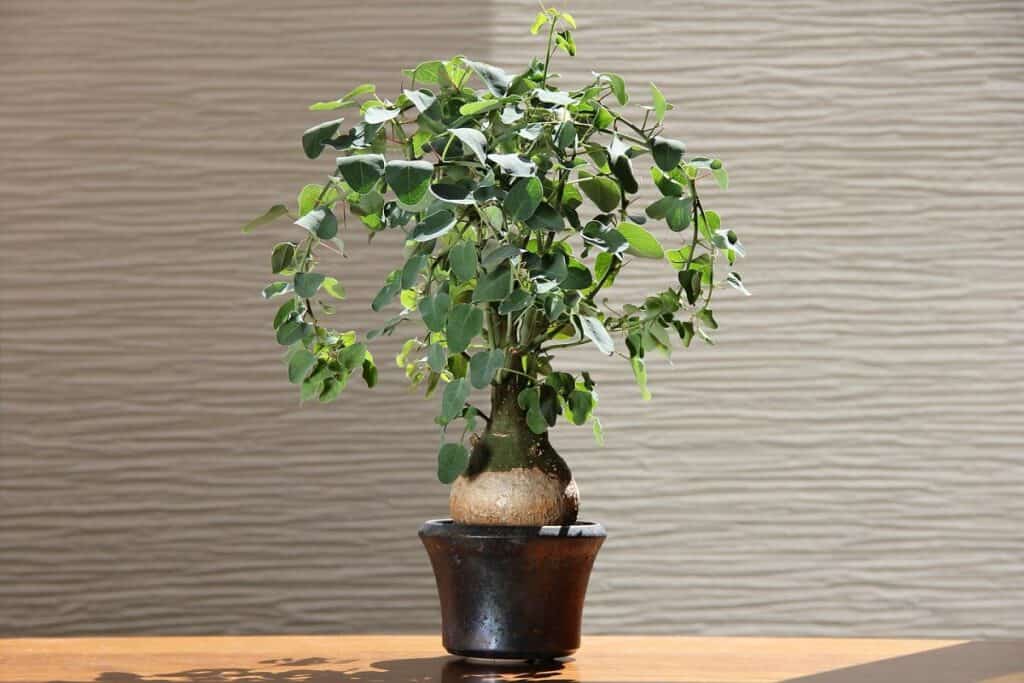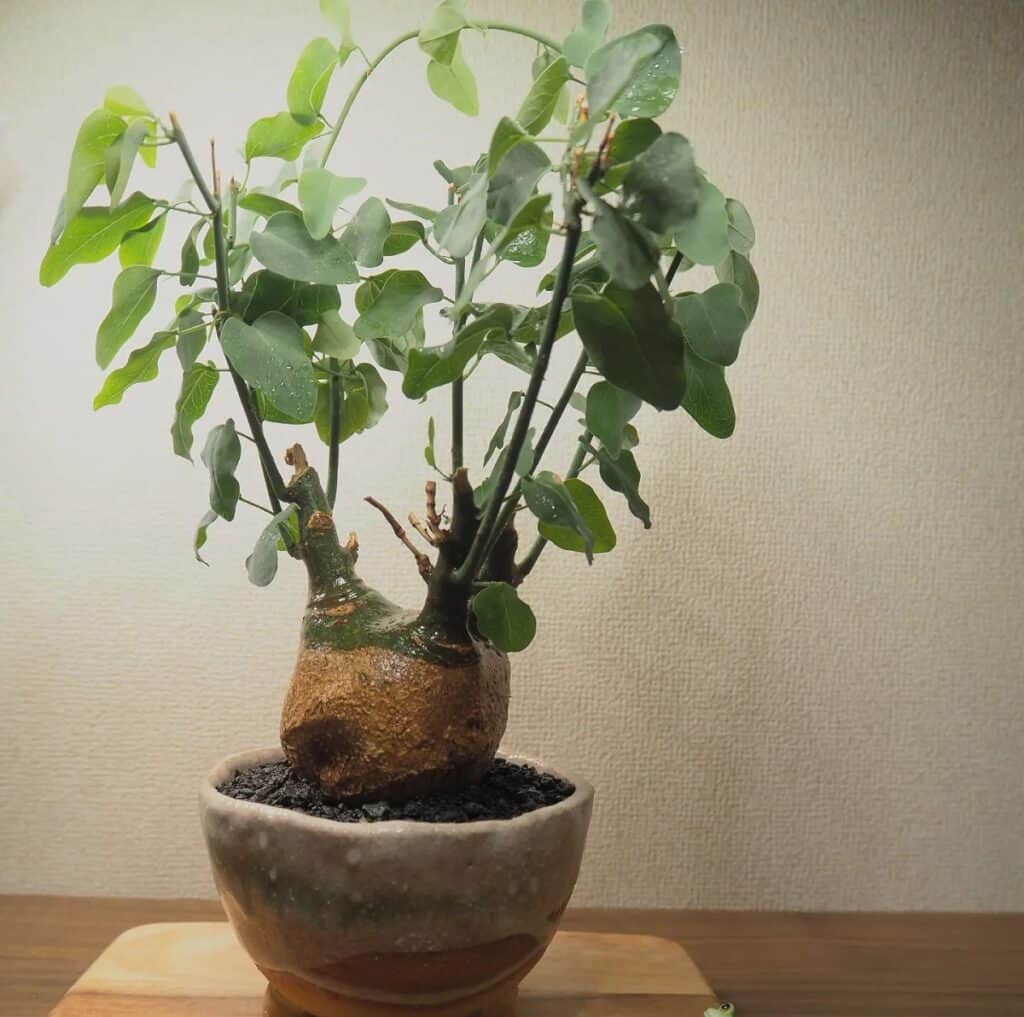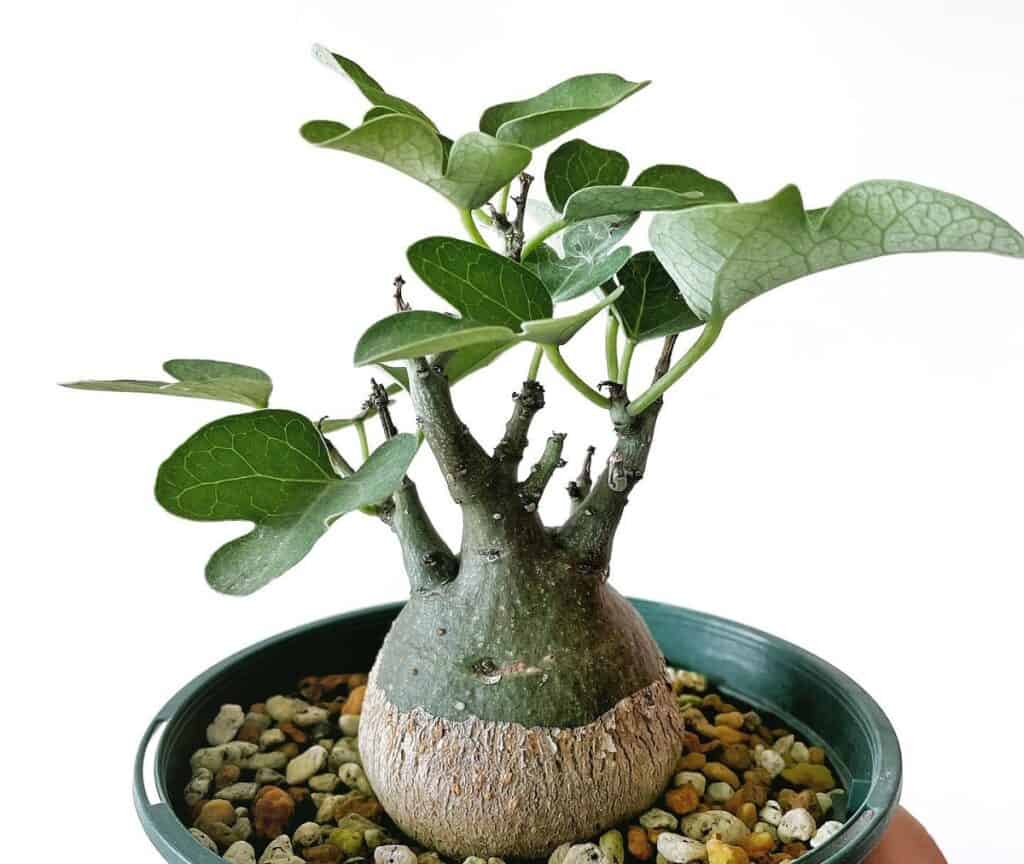Adenia spinosa: A Spiny Shrub Like No Other
Prepare to be charmed by Adenia spinosa, a delightfully prickly plant that stands out from the crowd. This fascinating shrub, native to South Africa, boasts a striking appearance with its thick, succulent stem branching into an array of spines and leaves.

Contents
About Adenia spinosa
Belonging to the Passifloraceae family, Adenia spinosa is a botanical gem that captures attention with its unique features. The branches adorned with thorns create an intriguing contrast against the dark green, oval or elliptical leaves. But the true showstoppers are the creamy yellow flowers that bloom into oval-shaped fruits, adding a touch of natural whimsy to this already captivating species.
Related Post:
1,000 Types of Succulents [With Pictures]
How to Care for Adenia spinosa
Light
Adenia spinosa thrives in direct sunlight, craving at least 5 to 8 hours of glorious rays each day. However, don’t let the midday sun scorch its leaves – a bit of shade during the hottest hours will keep your prickly pal happy. If you’re growing it indoors, a grow light can work wonders, mimicking the sun’s warmth and ensuring your Adenia spinosa flourishes.
Water
When it comes to watering, Adenia spinosa isn’t a diva – it just needs a little TLC. Check the soil’s moisture level by sticking your finger in (carefully, of course!) and water only when the top few inches feel dry. During the cooler months, your spiny companion will shed most of its leaves, so you can ease up on the watering, giving it a drink once every week or so.
Soil
Adenia spinosa loves a well-draining, gritty soil mix that’s rich in nutrients and slightly acidic. A succulent or cactus potting mix is perfect, but you can also add pumice stone for extra aeration and drainage, or perlite to help retain moisture while still allowing excess water to escape.

Fertilizer
Feeding your Adenia spinosa is a must during its growing season. Treat it to a succulent- and cacti-friendly fertilizer every 2 to 3 weeks in spring and summer. But when the cooler months roll around, let your prickly pal rest and hold off on the fertilizer until spring returns.
Temperature and Humidity
Adenia spinosa thrives in warm, bright conditions, with an ideal temperature around 70°F (21°C). While it can handle some heat, consistently chilly temperatures below 40°F (4°C) are a no-go – this plant isn’t built for frost. As for humidity, Adenia spinosa prefers drier conditions, so no need to worry about misting or humidifiers.
Pests and Problems
While Adenia spinosa isn’t a magnet for pests, it’s always wise to keep an eye out for mealybugs, spider mites, and other unwanted visitors during spring and summer. If you spot any critters trying to crash the party, a strong blast from the hose should send them packing. Remember, overwatering can lead to fungal or bacterial diseases, so watch for any signs of trouble and act accordingly.
Pruning
Adenia spinosa isn’t a high-maintenance diva when it comes to pruning. If you see any wilted or dying leaves, feel free to snip them off for a neater appearance. But beyond that, there’s no real need for regular pruning – just be sure to wear gloves when handling this prickly beauty to avoid any unwanted encounters with its poisonous sap.
Potting and Repotting
Repotting Adenia spinosa isn’t a frequent chore – you’ll only need to do it every 3 years or so, during its growing season. If you notice roots poking out of the pot, though, that’s a sign your prickly pal needs some extra room to stretch out. When repotting, handle with care and watch out for those thorns!

Adenia spinosa Propagation Methods
Increasing your prickly plant population is a delightful prospect with Adenia spinosa. This resilient shrub offers two main propagation methods, each with its own unique benefits.
Sowing Seeds
This is the simplest and most recommended approach for propagating Adenia spinosa. However, it’s important to note that plants grown from seeds may take several years to become fully established and develop their characteristic caudex (swollen stem base).
To propagate from seeds, follow these steps:
- Obtain fresh seeds from a reliable source
- Fill a seedling tray or pot with a well-draining seed-starting mix
- Sow the seeds about 1/4 inch (0.6 cm) deep, spacing them 2-3 inches (5-7.6 cm) apart
- Water the soil gently, taking care not to displace the seeds
- Cover the tray or pot with a plastic dome or wrap to maintain humidity
- Place the tray or pot in a warm, bright location (around 70-85°F or 21-29°C)
- Once the seeds germinate (usually within 2-4 weeks), remove the cover and continue caring for the seedlings, providing bright light and regular watering
Stem Cuttings
While propagating from stem cuttings is possible, it’s essential to note that plants grown this way may not develop the characteristic caudex that Adenia spinosa is known for. However, this method is useful if you’re primarily interested in seed production.
To propagate from stem cuttings, follow these steps:
- Take a 4-6 inch (10-15 cm) cutting from a healthy, mature plant, using a clean, sharp knife or pruners
- Remove the bottom leaves and allow the cutting to callus over for a few days
- Dip the cut end in a rooting hormone powder to encourage root development
- Fill a small pot with a well-draining rooting medium, such as a mixture of perlite and coarse sand
- Make a hole in the center of the pot and insert the cutting, gently firming the medium around it
- Water the pot and cover it with a plastic bag or dome to maintain humidity
- Place the pot in a warm, bright location (around 70-85°F or 21-29°C)
- Once roots have developed (usually within 4-8 weeks), transplant the cutting into a larger pot with a well-draining cactus or succulent potting mix
Remember, patience is key when propagating Adenia spinosa, as this slow-growing plant takes its time to reach maturity. With proper care and attention, you’ll soon have a prickly paradise of your very own.
